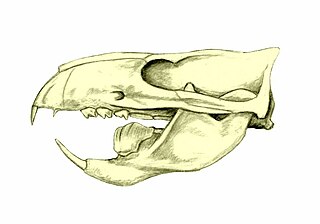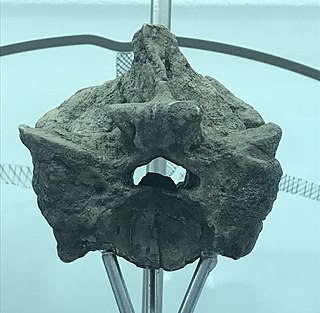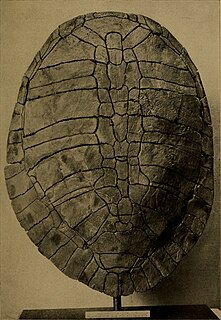The Paleogene is a geologic period and system that spans 43 million years from the end of the Cretaceous Period 66 million years ago (Mya) to the beginning of the Neogene Period 23.03 Mya. It is the beginning of the Cenozoic Era of the present Phanerozoic Eon. The earlier term Tertiary Period was used to define the span of time now covered by the Paleogene Period and subsequent Neogene Period; despite no longer being recognised as a formal stratigraphic term, 'Tertiary' is still widely found in earth science literature and remains in informal use. Paleogene is often abbreviated "Pg".

Ptilodus is a genus of mammals from the extinct order of Multituberculata, and lived during the Paleocene in North America.
Neoplagiaulax is a mammal genus from the Paleocene of Europe and North America. In the case of the latter continent, there may possibly be some slightly earlier, Upper Cretaceous material too. It existed in the age immediately following the extinction of the last dinosaurs. This animal was a member of the extinct order Multituberculata, lying within the suborder Cimolodonta and family Neoplagiaulacidae.
Mimetodon is a small mammal from the Paleocene of North America and perhaps Europe. It was a member of the extinct order Multituberculata within the suborder Cimolodonta and family Neoplagiaulacidae.
Parectypodus is an extinct genus of mammals that lived from Late Cretaceous (Maastrichtian) to Eocene time in North America. It is a member of the extinct order of Multituberculata, suborder Cimolodonta, family Neoplagiaulacidae. It was named by G.L. Jepsen in 1930.
Kimbetohia is a genus of mammal belonging to the extinct order Multituberculata. It lived from the Upper Cretaceous to the Paleocene in the United States.
Microcosmodon is a mammal genus from the Paleocene of North America. It was a member of the extinct order Multituberculata, and lies within the suborder Cimolodonta and family Microcosmodontidae. The genus Microcosmodon was named by G.L. Jepsen in 1930.
Hainina is an extinct mammal genus from the latest Cretaceous to the Paleocene of Europe.
The Thanetian is, in the ICS Geologic timescale, the latest age or uppermost stratigraphic stage of the Paleocene Epoch or Series. It spans the time between 59.2 and56 Ma. The Thanetian is preceded by the Selandian Age and followed by the Ypresian Age. The Thanetian is sometimes referred to as the Late Paleocene.

Dinocerata is an extinct order of plant-eating hoofed mammals with horns and protuberant canine teeth.

Prodinoceras is the earliest known uintathere genus, which lived in the late Paleocene of Mongolia. It was a relatively small uintathere, reaching 2.9 m in length. It is also regarded as the most basal uintathere, as, although it had the characteristic fang-like tusks, it had yet to evolve the characteristic knob-like horns.

Berru is a commune in the Marne department in northeastern France.

Cernay-lès-Reims is a commune in the Marne department in north-eastern France.
Arabemys is an extinct genus of sea turtle. It was first named in 1999, and contains one species, A. crassiscutata. It is known from deposits of Late Paleocene or Early Eocene age near the village of Linah in northern Saudi Arabia.
The Paleocene, or Palaeocene, is a geological epoch that lasted from about 66 to 56 million years ago (mya). It is the first epoch of the Paleogene Period in the modern Cenozoic Era. The name is a combination of the Ancient Greek παλαιός palaiós meaning "old" and the Eocene Epoch, translating to "the old part of the Eocene".

Titanoboa is an extinct genus of very large snakes that lived in what is now La Guajira in northeastern Colombia. They could grow up to 12.8 m (42 ft), perhaps even 14.3 m (47 ft) long and reach a weight of 1,135 kg (2,500 lb). This snake lived during the Middle to Late Paleocene epoch, around 60 to 58 million years ago following the extinction of the dinosaurs. Although originally thought to be an apex predator, the discovery of skull bones revealed that it was more than likely specialized in preying on fish. The only known species is Titanoboa cerrejonensis, the largest snake ever discovered, which supplanted the previous record holder, Gigantophis garstini.
Compsemys is an extinct genus of prehistoric turtles from the Late Cretaceous and Paleocene of North America and possibly Europe. The type species C. victa, first described by Joseph Leidy from the Hell Creek Formation in Montana in 1856, and another probable species C. russelli, described in 2012, from Paleocene deposits in France. Its affinites have long been uncertain, but it has recently been considered to be the most basal member of Paracryptodira, despite the clade first appearing in the Late Jurassic, and is sometimes included in its own family, Compsemydidae. A revision in 2020 found Compsemydidae to be more expansive, also containing Riodevemys and Selenemys from the Late Jurassic of Europe, and Peltochelys from the Early Cretaceous of Europe.
Cerrejonemys wayuunaiki is an extinct podocnemid turtle which existed in Colombia during the Paleogene period; the Middle to Late Paleocene epoch.

Puentemys is an extinct genus of bothremydid turtle from the Paleocene-age Cerrejón Formation in Colombia. It is the largest known bothremydid with a shell length of up to 1.51 m (5.0 ft). Puentemys is the only Paleocene bothremydid known from South America, and is most closely related to the genus Foxemys from the Late Cretaceous of Europe, showing that Bothremydini, the tribe of bothremydids to which Puentemys belonged, had a nearly worldwide distribution across the K-T boundary. The ancestors of Puentemys may have reached South America by dispersing across Paleocene coastlines or by riding currents across the Atlantic Ocean.

Macrobaenidae is an extinct family of turtles, known from the Early Cretaceous to Paleogene of Laurasia. Their relationships to other turtles and whether or not they form a monophlyletic group are controversial. They are typically interpreted as stem or crown group cryptodires, but some more recent analyses have found them to lie outside crown group Testudines. Macrobaenids can be distinguished from other testudinatans by the presence of a carotid fenestra, cruciform plastron with strap-like epiplastra, and a lack of extragulars.







